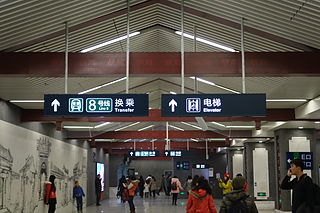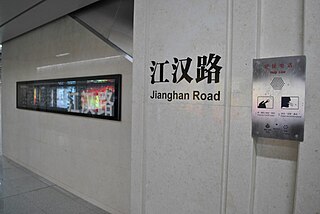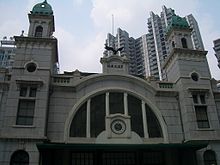
Wuhan Tianhe International Airport serves Wuhan, the capital of the Hubei province, People's Republic of China. It was opened on 15 April 1995 substituting the old Hankou Wangjiadun Airport and Nanhu Airport as the major airport of Wuhan. The airport is located in Wuhan's suburban Huangpi District, around 26 km (16 mi) to the north of Wuhan city center. It is the busiest airport of central China as it is geographically located in the centre of China's airline route network. The airport is a focus city for Air China, China Eastern Airlines and China Southern Airlines. The airport has flights to international destinations such as Bangkok, Moscow, Osaka, Paris, Seoul, and Singapore.

Line 9 of the Beijing Subway is a rapid transit line in western Beijing. The line runs 16.5 km (10.3 mi) from the National Library in Haidian District to Guogongzhuang in Fengtai District with 13 stations. All stations are fully underground. Line 9's color is chartreuse.

The Line 1 of Wuhan Metro is an elevated metro line in the city of Wuhan, Hubei. It is the longest continuous metro viaduct in the world. Line 1 opened on 28 July 2004, making Wuhan the fifth city in mainland China to have a metro system after Beijing, Tianjin, Shanghai, Guangzhou. This is the first Metro line in China wrongly referred to as a light rail line in Chinese terminology because it is elevated. Originally a branch line was planned to cross the Yangtze to Wuchang District via the Second Wuhan Yangtze River Bridge. The Second Wuhan River Bridge even had a provision in the central median where Line 1 trains would run in anticipation for the branch line when it opened in 1995. However by 2003 the reservation was removed to allow for more traffic lanes when the bridge was undergoing renovation.

The Line 2 of Wuhan Metro is the first underground metro line crossing the Yangtze River. This line has started trial run on September 25, 2012, and has opened on December 28, 2012. It is Wuhan's second metro line after Line 1, and the city's first underground line, since Line 1 is mostly elevated. Line 2 runs in a northwest-southeast direction, connecting Hankou and Wuchang, including Hankou Railway Station and major commercial districts.

The Line 4 of Wuhan Metro is the third line in Wuhan Metro system, and it will be the second metro line crossing the Yangtze river in Wuhan. It is colored grass-green, which is the identifying color of this line, which would appear on its trains, station signs, and the official subway map.

Nanluoguxiang is a station on Line 6 and Line 8 of the Beijing Subway in central Beijing. The station opened on December 30, 2012 to Line 6 service, and to Line 8 service in December 2013. It is located near to the south entrance of the Nanluoguxiang alley, after which it is named. It will also become a transfer station for the Planned Phase 2 of Line 3 in the future.

Jinmalu station is an interchange station between Line 2 and Line 4 of the Nanjing Metro. It is located to the north of Jinma Road and south of Benma Road (奔马路), parallel to Shishi Road (石狮路) in Qixia District. It started operations on 28 May 2010 along with the rest of Line 2; the interchange with Line 4 opened on 18 January 2017 along with the rest of that line.

Dijiao is a station of Line 1 of the Wuhan Metro, opened along with the completion of Line 1 on July 29, 2010. It is an elevated station situated on Jiefang Avenue, with easy access to Dijiao Park and bus transfers to Hankou North. The station has two side platforms. Trains terminating at Dijiao Station uses a single crossover to access the westbound platform. The eastbound platform has entered fared service for Line 1's Hankou North extension on July 28, 2014.

Erqi Road is a station on Line 1 of Wuhan Metro, opened upon the completion of Line 1 on July 29, 2010. It is an elevated station situated at the intersection of Jiefang Avenue and Erqi Road. The station has one island platform and two siding tracks to the north of the station, connected by a pair of crossover tracks, accommodating trains entering and exiting services during peak hours.

Huangpu Road Station serves as an interchange station of Line 1 of Wuhan Metro and the planned Line 8. It entered revenue service along with the completion of Line 1, Phase 1 on July 28, 2004. Currently, only the elevated station for Line 1 was constructed. The station situates at the intersection of Jinghan Avenue and Lugouqiao Road. Before Phase 2, Huangpu Road Station was the northernmost terminus on Line 1. A single crossover was installed just south of the station to accommodate for trains entering terminus prior to 2010. The underground platforms for Line 8 has not been built yet.
Sanyang Road Station serves as an interchange station of Line 1 and Line 7 of Wuhan Metro. The elevated station entered revenue service along with the completion of Line 1, Phase 1 on July 28, 2004, and the underground station entered service on October 1, 2018 with the opening of Line 7.

Wuhan Metropolitan Area intercity railway or Wuhan Metropolitan Area intercity railway system is a network of high-speed commuter railways in and around Wuhan, the capital of the Chinese province Hubei. The first line of the system opened at the end of 2013, two more in mid-2014, one in 2016.

Wuhan Metro Museum is a transport museum located in Jianghan District, Wuhan, China, next to the D1 exit of the Wangjiadun East Station on Line 2, Wuhan Metro. Its main exhibition includes the culture and history of Wuhan Metro, as well as the history of Metro in the world.

Xunlimen Station is an interchange station between Line 1 and Line 2 of the Wuhan Metro. It entered revenue service along with the completion of Line 1 on July 28, 2004. The Line 2 platforms opened on December 28, 2012. It is located between Jianghan District and Jiangan District.

Taipingyang Station, or literally Pacific Station, is a station of Line 1 of Wuhan Metro. It entered revenue service on April 8, 2006. It is located in Qiaokou District.

Jianghan Road Station, is an interchange station and Line 2 and Line 6 of the Wuhan Metro. It entered revenue service on December 28, 2012. It is located in Jianghan District.

Zhongnan Road Station is an interchange station of Line 2 and Line 4 of Wuhan Metro. It entered revenue service on December 28, 2012. It is located in Wuchang District.

The Line 3 of Wuhan Metro is a metro line in Wuhan.. This line crosses five districts of Wuhan: Jiang'an District, Jianghan District, Qiaokou District, Hanyang District and Hannan District, and is the first line to cross the Han River. It started operation on December 28, 2015.

Trams in Wuhan may refer to any one of the tram systems currently operational in the city of Wuhan, Hubei, China. The first tram started revenue service in Wuhan is the Auto-city T1 Line, which began on July 28, 2017. Subsequently, Optics Valley tram started revenue service from April 1, 2018.






















